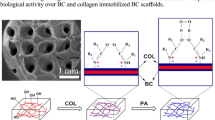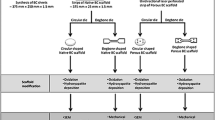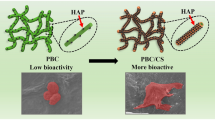Abstract
Macroporous bacterial cellulose (MBC) scaffolds composed of BC fragments have received much attention in bone tissue engineering due to their simplicity in preparation process. However, the use of BC fragments and the sole polysaccharide component of BC inevitably lead to MBC scaffolds with low mechanical properties and inadequate biocompatibility and osteogenic property. Herein, physically and chemically crosslinked macroporous BC/Ti3C2Tx (pc-MBC/Ti3C2Tx) scaffolds were successfully prepared by combining physical and chemical crosslinking strategies. The simultaneous physical crosslinking (hydrogen bonds between Ti3C2Tx nanosheets and the nanofibers of BC fragments) and chemical crosslinking (amide bonds among the residual trace proteins on the nanofibers of BC fragments) exhibit an obvious synergistic effect on the improvement of mechanical properties of pc-MBC/Ti3C2Tx scaffolds. The maximum compressive strength (124.28 ± 5.04 kPa at 80% strain) and modulus (40.78 ± 3.01 kPa) of pc-MBC/Ti3C2Tx scaffold are about 3–9 and 3–10 times as high as the counterparts, respectively. In addition, the interconnected macropores can effectively support the migration and penetration of MC3T3-E1 cells into pc-MBC/Ti3C2Tx scaffolds. More importantly, pc-MBC/Ti3C2Tx scaffolds are superior to the counterpart without Ti3C2Tx nanosheets in terms of viability, adhesion, spreading, and osteogenic differentiation of MC3T3-E1 cells. These obtained results indicate that pc-MBC/Ti3C2Tx scaffolds hold considerable potential for bone tissue engineering.










Similar content being viewed by others
Data availability
All data generated or analyzed during this work are included in this publication.
References
Cao W-T, Chen F-F, Zhu Y-J, Zhang Y-G, Jiang Y-Y, Ma M-G, Chen F (2018) Binary strengthening and toughening of MXene/cellulose nanofiber composite paper with nacre-inspired structure and superior electromagnetic interference shielding properties. ACS Nano 12:4583–4593. https://doi.org/10.1021/acsnano.8b00997
Chen K, Qiu N, Deng Q, Kang M-H, Yang H, Baek J-U, Koh Y-H, Du S, Huang Q, Kim H-E (2017) Cytocompatibility of Ti3AlC2, Ti3SiC2, and Ti2AlN: in vitro tests and first-principles calculations. ACS Biomater Sci Eng 3:2293–2301. https://doi.org/10.1021/acsbiomaterials.7b00432
Chen K, Chen Y, Deng Q, Jeong S-H, Jang T-S, Du S, Kim H-E, Huang Q, Han C-M (2018) Strong and biocompatible poly(lactic acid) membrane enhanced by Ti3C2Tz (MXene) nanosheets for Guided bone regeneration. Mater Lett 229:114–117. https://doi.org/10.1016/j.matlet.2018.06.063
Chen C, Ding W, Zhang H, Zhang L, Huang Y, Fan M, Yang J, Sun D (2022) Bacterial cellulose-based biomaterials: from fabrication to application. Carbohydr Polym 278:118995. https://doi.org/10.1016/j.carbpol.2021.118995
French AD (2014) Idealized powder diffraction patterns for cellulose polymorphs. Cellulose 21:885–896. https://doi.org/10.1007/s10570-013-0030-4
Gross KA, Rodríguez-Lorenzo LM (2004) Biodegradable composite scaffolds with an interconnected spherical network for bone tissue engineering. Biomaterials 25:4955–4962. https://doi.org/10.1016/j.biomaterials.2004.01.046
Haugen HJ, Lyngstadaas SP, Rossi F, Perale G (2019) Bone grafts: which is the ideal biomaterial? J Clin Periodontol 46:92–102. https://doi.org/10.1111/jcpe.13058
Huang R, Chen X, Dong Y, Zhang X, Wei Y, Yang Z, Li W, Guo Y, Liu J, Yang Z, Wang H, Jin L (2020) MXene composite nanofibers for cell culture and tissue engineering. ACS Appl Bio Mater 3:2125–2131. https://doi.org/10.1021/acsabm.0c00007
Iravani S, Varma RS (2021) MXenes and MXene-based materials for tissue engineering and regenerative medicine: recent advances. Mater Adv 2:2906–2917. https://doi.org/10.1039/d1ma00189b
Jiao S, Zhou A, Wu M, Hu H (2019) Kirigami patterning of MXene/bacterial cellulose composite paper for all-solid-state stretchable micro-supercapacitor arrays. Adv Sci 6:1900529. https://doi.org/10.1002/advs.201900529
Li F, Yan Y, Wang Y, Fan Y, Zou H, Liu H, Luo R, Li R, Liu H (2021) A bifunctional MXene-modified scaffold for photothermal therapy and maxillofacial tissue regeneration. Regen Biomater 8:rbab057. https://doi.org/10.1093/rb/rbab057
Li K, Li J, Zhu Q, Xu B (2022a) Three-dimensional MXenes for supercapacitors: a review. Small Methods 6:2101537. https://doi.org/10.1002/smtd.202101537
Li Y, Xun X, Xu Y, Zhan A, Gao E, Yu F, Wang Y, Luo H, Yang C (2022b) Hierarchical porous bacterial cellulose scaffolds with natural biomimetic nanofibrous structure and a cartilage tissue-specific microenvironment for cartilage regeneration and repair. Carbohydr Polym 276:118790. https://doi.org/10.1016/j.carbpol.2021.118790
Lin H, Chen Y, Shi J (2018) Insights into 2D MXenes for versatile biomedical applications: current advances and challenges ahead. Adv Sci 5:1800518. https://doi.org/10.1002/advs.201800518
Lin X, Li Z, Qiu J, Wang Q, Wang J, Zhang H, Chen T (2021) Fascinating MXene nanomaterials: emerging opportunities in the biomedical field. Biomater Sci 9:5437–5471. https://doi.org/10.1039/d1bm00526j
Ling T, Zha X, Zhou K, Zhao X, Jia J, Pan K, Chen A, Yang W, Zhou Z (2022) A facile strategy toward hierarchically porous composite scaffold for osteosarcoma ablation and massive bone defect repair. Compos Part B 234:109660. https://doi.org/10.1016/j.compositesb.2022.109660
Liu L, Ji X, Mao L, Wang L, Chen K, Shi Z, Ahmed AAQ, Thomas S, Vasilievich RV, Xiao L, Li X, Yang G (2022) Hierarchical-structured bacterial cellulose/potato starch tubes as potential small-diameter vascular grafts. Carbohydr Polym 281:119034. https://doi.org/10.1016/j.carbpol.2021.119034
Lu Z, Jia F, Zhuo L, Ning D, Gao K, Xie F (2021) Micro-porous MXene/Aramid nanofibers hybrid aerogel with reversible compression and efficient EMI shielding performance. Compos Part B 217:108853. https://doi.org/10.1016/j.compositesb.2021.108853
Luo H, Ao H, Peng M, Yao F, Yang Z, Wan Y (2019) Effect of highly dispersed graphene and graphene oxide in 3D nanofibrous bacterial cellulose scaffold on cell responses: a comparative study. Mater Chem Phys 235:121774. https://doi.org/10.1016/j.matchemphys.2019.121774
Luo H, Gan D, Gama M, Tu J, Yao F, Zhang Q, Ao H, Yang Z, Li J, Wan Y (2020) Interpenetrated nano- and submicro-fibrous biomimetic scaffolds towards enhanced mechanical and biological performances. Mater Sci Eng C 108:110416. https://doi.org/10.1016/j.msec.2019.110416
Mao L, Hu S, Gao Y, Wang L, Zhao W, Fu L, Cheng H, Xia L, Xie S, Ye W, Shi Z, Yang G (2020) Biodegradable and electroactive regenerated bacterial cellulose/MXene (Ti3C2Tx) composite hydrogel as wound dressing for accelerating skin wound healing under electrical stimulation. Adv Healthc Mater 9:2000872. https://doi.org/10.1002/adhm.202000872
Mao L, Wang L, Zhang M, Ullah MW, Liu L, Zhao W, Li Y, Ahmed AAQ, Cheng H, Shi Z, Yang G (2021) In situ synthesized selenium nanoparticles-decorated bacterial cellulose/gelatin hydrogel with enhanced antibacterial, antioxidant, and anti-inflammatory capabilities for facilitating skin wound healing. Adv Healthc Mater 10:2100402. https://doi.org/10.1002/adhm.202100402
Mi X, Su Z, Fu Y, Li S, Mo A (2022) 3D printing of Ti3C2-MXene-incorporated composite scaffolds for accelerated bone regeneration. Biomed Mater 17:035002. https://doi.org/10.1088/1748-605x/ac5ffe
Noh YK, Dos Santos Da Costa A, Park YS, Du P, Kim I-H, Park K (2019) Fabrication of bacterial cellulose-collagen composite scaffolds and their osteogenic effect on human mesenchymal stem cells. Carbohydr Polym 219:210–218. https://doi.org/10.1016/j.carbpol.2019.05.039
Ou R, Wei J, Jiang L, Simon GP, Wang H (2016) Robust thermoresponsive polymer composite membrane with switchable superhydrophilicity and superhydrophobicity for efficient oil-water separation. Environ Sci Technol 50:906–914. https://doi.org/10.1021/acs.est.5b03418
Pan S, Yin J, Yu L, Zhang C, Zhu Y, Gao Y, Chen Y (2020) 2D MXene-integrated 3D-printing scaffolds for augmented osteosarcoma phototherapy and accelerated tissue reconstruction. Adv Sci 7:1901511. https://doi.org/10.1002/advs.201901511
Panaitescu DM, Frone AN, Chiulan I, Casarica A, Nicolae CA, Ghiurea M, Trusca R, Damian CM (2016) Structural and morphological characterization of bacterial cellulose nano-reinforcements prepared by mechanical route. Mater Des 110:790–801. https://doi.org/10.1016/j.matdes.2016.08.052
Pi M, Jiang L, Wang Z, Cui W, Shi L, Ran R (2021) Robust and ultrasensitive hydrogel sensors enhanced by MXene/cellulose nanocrystals. J Mater Sci 56:8871–8886. https://doi.org/10.1007/s10853-020-05644-w
Priya G, Madhan B, Narendrakumar U, Suresh Kumar RV, Manjubala I (2021) In vitro and in vivo evaluation of carboxymethyl cellulose scaffolds for bone tissue engineering applications. ACS Omega 6:1246–1253. https://doi.org/10.1021/acsomega.0c04551
Qu H, Fu H, Han Z, Sun Y (2019) Biomaterials for bone tissue engineering scaffolds: a review. RSC Adv 9:26252–26262. https://doi.org/10.1039/c9ra05214c
Singhsa P, Narain R, Manuspiya H (2018) Physical structure variations of bacterial cellulose produced by different Komagataeibacter xylinus strains and carbon sources in static and agitated conditions. Cellulose 25:1571–1581. https://doi.org/10.1007/s10570-018-1699-1
Song J, Chen C, Yang Z, Kuang Y, Li T, Li Y, Huang H, Kierzewski I, Liu B, He S, Gao T, Yuruker SU, Gong A, Yang B, Hu L (2018) Highly compressible, anisotropic aerogel with aligned cellulose nanofibers. ACS Nano 12:140–147. https://doi.org/10.1021/acsnano.7b04246
Torgbo S, Sukyai P (2018) Bacterial cellulose-based scaffold materials for bone tissue engineering. Appl Mater Today 11:34–49. https://doi.org/10.1016/j.apmt.2018.01.004
Wan Y, Cui T, Zhang Q, Yang Z, Yao F, Luo H (2018) Submicrofiber-incorporated 3D bacterial cellulose nanofibrous scaffolds with enhanced cell performance. Macromol Mater Eng 303:1800316. https://doi.org/10.1002/mame.201800316
Wan Y, Xiong P, Liu J, Feng F, Xun X, Gama FM, Zhang Q, Yao F, Yang Z, Luo H, Xu Y (2021) Ultrathin, strong, and highly flexible Ti3C2Tx MXene/bacterial cellulose composite films for high-performance electromagnetic interference shielding. ACS Nano 15:8439–8449. https://doi.org/10.1021/acsnano.0c10666
Wan H-Y, Shin RLY, Chen JCH, Assunção M, Wang D, Nilsson SK, Tuan RS, Blocki A (2022) Dextran sulfate-amplified extracellular matrix deposition promotes osteogenic differentiation of mesenchymal stem cells. Acta Biomater 140:163–177. https://doi.org/10.1016/j.actbio.2021.11.049
Wang L, Lu C, Li Y, Wu F, Zhao B, Dong X (2015) Green fabrication of porous silk fibroin/graphene oxide hybrid scaffolds for bone tissue engineering. RSC Adv 5:78660–78668. https://doi.org/10.1039/c5ra12173f
Wang Z, Han X, Han X, Chen Z, Wang S, Pu J (2021) MXene/wood-derived hierarchical cellulose scaffold composite with superior electromagnetic shielding. Carbohydr Polym 254:117033. https://doi.org/10.1016/j.carbpol.2020.117033
Wu J, Yin N, Chen S, Weibel DB, Wang H (2019) Simultaneous 3D cell distribution and bioactivity enhancement of bacterial cellulose (BC) scaffold for articular cartilage tissue engineering. Cellulose 26:2513–2528. https://doi.org/10.1007/s10570-018-02240-9
Wu M, Chen F, Wu P, Yang Z, Zhang S, Xiao L, Deng Z, Zhang C, Chen Y, Cai L (2021) Nanoclay mineral-reinforced macroporous nanocomposite scaffolds for in situ bone regeneration: in vitro and in vivo studies. Mater Des 205:109734. https://doi.org/10.1016/j.matdes.2021.109734
Xiao J, Wei Q, Xue J, Liu Z, Li Z, Zhou Z, Chen F, Zhao F (2022) Mesoporous bioactive glass/bacterial cellulose composite scaffolds for bone support materials. Colloids Surf A 642:128693. https://doi.org/10.1016/j.colsurfa.2022.128693
Xiong G, Luo H, Zhang C, Zhu Y, Wan Y (2015) Enhanced biological behavior of bacterial cellulose scaffold by creation of macropores and surface immobilization of collagen. Macromol Res 23:734–740. https://doi.org/10.1007/s13233-015-3099-9
Xu J, Liu X, Ren X, Gao G (2018) The role of chemical and physical crosslinking in different deformation stages of hybrid hydrogels. Eur Polym J 100:86–95. https://doi.org/10.1016/j.eurpolymj.2018.01.020
Xun X, Li Y, Zhu X, Zhang Q, Lu Y, Yang Z, Wan Y, Yao F, Deng X, Luo H (2021) Fabrication of robust, shape recoverable, macroporous bacterial cellulose scaffolds for cartilage tissue engineering. Macromol Biosci 21:2100167. https://doi.org/10.1002/mabi.202100167
Yin N, Stilwell MD, Santos TMA, Wang H, Weibel DB (2015) Agarose particle-templated porous bacterial cellulose and its application in cartilage growth in vitro. Acta Biomater 12:129–138. https://doi.org/10.1016/j.actbio.2014.10.019
Zaborowska M, Bodin A, Backdahl H, Popp J, Goldstein A, Gatenholm P (2010) Microporous bacterial cellulose as a potential scaffold for bone regeneration. Acta Biomater 6:2540–2547. https://doi.org/10.1016/j.actbio.2010.01.004
Zhan Z, Song Q, Zhou Z, Lu C (2019) Ultrastrong and conductive MXene/cellulose nanofiber films enhanced by hierarchical nano-architecture and interfacial interaction for flexible electromagnetic interference shielding. J Mater Chem C 7:9820–9829. https://doi.org/10.1039/C9TC03309B
Zhang H, Wang ZG, Zhang ZN, Wu J, Zhang J, He JS (2007) Regenerated-cellulose/multiwalled-carbon-nanotube composite fibers with enhanced mechanical properties prepared with the ionic liquid 1-Allyl-3-methylimidazolium chloride. Adv Mater 19:698–704. https://doi.org/10.1002/adma.200600442
Zhang W, Wang XC, Li XY, Zhang LL, Jiang F (2020) A 3D porous microsphere with multistage structure and component based on bacterial cellulose and collagen for bone tissue engineering. Carbohydr Polym 236:116043. https://doi.org/10.1016/j.carbpol.2020.116043
Zhang J, Ma Y, Han Y, Xu K, Yao S, Shi L, Zhu M (2023) 3D porous structure assembled from MXene via breath figure method for electrochemical detection of dopamine. Chem Eng J 452:139414. https://doi.org/10.1016/j.cej.2022.139414
Acknowledgments
Not applicable.
Funding
This work was supported by the National Natural Science Foundation of China (Grant Nos. 32000947 and 31870963), Jiangxi Provincial Natural Science Foundation (Grant Nos. 20202ACBL214007 and 20202ACBL204013), and Jiangxi Provincial Graduate Innovation Special Fund Project (Grant No. YC2022-s569).
Author information
Authors and Affiliations
Contributions
ZY: Methodology, Writing-original draft, Funding acquisition. YZ: Methodology, Investigation, Validation. YC: Data curation, Funding acquisition. ZY: Conceptualization. TC: Formal analysis. HL: Methodology, Funding acquisition. YL: Conceptualization, Writing-review and editing. YW: Writing-review and editing, Supervision, Project administration.
Corresponding authors
Ethics declarations
Conflict of interest
The authors declare that there are no known conflicts of interest associated with this publication and there has been no financial support for this work that could have influenced its outcome.
Consent for publication
Not applicable.
Ethical approval and consent to participate
This article does not contain any studies with human participants or animals performed by any of the authors.
Additional information
Publisher’s Note
Springer Nature remains neutral with regard to jurisdictional claims in published maps and institutional affiliations.
Supplementary Information
Below is the link to the electronic supplementary material.
Rights and permissions
Springer Nature or its licensor (e.g. a society or other partner) holds exclusive rights to this article under a publishing agreement with the author(s) or other rightsholder(s); author self-archiving of the accepted manuscript version of this article is solely governed by the terms of such publishing agreement and applicable law.
About this article
Cite this article
Yang, Z., Zhang, Y., Chen, Y. et al. Ti3C2Tx MXene-incorporated macroporous bacterial cellulose scaffolds with physical and chemical crosslinking for enhanced mechanical and biological performance. Cellulose 30, 6773–6785 (2023). https://doi.org/10.1007/s10570-023-05254-0
Received:
Accepted:
Published:
Issue Date:
DOI: https://doi.org/10.1007/s10570-023-05254-0




